SIX MONKEYS: Time Bandits (1981)
Previously: After Michael Palin’s father dies in a Caravaggio painting, he goes to the city and stumbles into the midst of several adventures and a poem. If Gilliam hadn’t already co-directed Holy Grail, this might have killed his career while establishing it…
For some reason, I always think that Brazil is Terry Gilliam’s second movie. I’m not sure why. But in my head he has the same narrative as Christopher Nolan: the first film is slight and underseen, basically an amateurish calling card, and then the second one has all the hallmarks that will underscore his auteur status for the rest of his career. And while that remains true regardless of whether Time Bandits or Brazil is his second offering to the movie gods, somehow it’s more impressive if it’s Brazil.
That said, I prefer Time Bandits. Is this in part because I saw it, in whole and in pieces, so many times as a child? Oh, almost certainly. There’s some powerful nostalgia baked into this film in three different ways. Actually, let’s just get into it:
Monkey 1 — Primary Primate: Because, as established in the introductory Six Monkeys post, I watched this so many times over at Geoff’s house, I don’t have a clear memory of watching it for the first time. What I have is a sense of how this movie fits in with other films of the time. In re-watching it, I can see details in the set-dressing of Kevin’s bedroom that helped make it feel real and helped establish the Proustian sensory detail that telescopes me back, Ratatouille-style, to the memories of my own childhood. Kevin’s dun-colored scratchy fake-wool blanket with the shiny polyester trim is absolutely a blanket that existed in my own bedroom, and is what I would swaddle my face in when I had the unaccountable sense that something was moving in the closet in the dark. Did I catch that particular detail when I was watching it in the ’80s? Absolutely not, because it’s almost impossible, as MacLuhan talks about, to see the context of the environment you’re in, and those blankets and those kid fears were too omnipresent to have been seen as a decision and not a default.
Monkey 2 — Infinite Typrewriters: Michael Palin’s diary volume Halfway to Hollywood opens with the extended process of Time Bandits with the first draft being written in a series of scene and story conferences between Palin and Gilliam over the course of January 1980 as a challenge to allow Palin to then concentrate on other work, but the refinement of the script then continues to interrupt his other plans and prevent Gilliam from attending general Python meetings in which the groundwork for what will become Meaning of Life. Palin films with Shelley Duvall in June, is still tweaking dialogue in September for looping, sees an assembly cut in October — “It really is the most exciting piece of filming I have seen in ages” (p.57) — and is editing the script for publication as a tie-in book in December when he hears the news of John Lennon’s death. Time Bandits: the movie script is not by the same publisher as the Holy Grail or Life of Brian script books (they are by Eyre Methuen, whereas this newer offering is from Doubleday Dolphin), but it has a similar vibe, with set photos and Gilliam storyboards collages in amongst the script pages, and a couple section of lavish color plates. While Palin has mentioned “the future scene” his his diaries multiple times (hence the rocketship Wally shows up in), including mentioning the day on which they decided to cut it, it does not appear here as a dangling thread. Maisie and Myrtle, though, cut from the film, are included in their strange The Furies-cum-Circe way, as are photos of their removed scene. Joan Hickson is credited as Myrtle in the final cast list in the book, but whoever played Maisie seems to be lost. The spider-women, as they’re sometimes referred to by Palin and Gilliam, do not appear in the children’s novelization of the film by Charles Alverson, but then again, neither does any of the superlative, hilarious dialogue between Vincent and Pansy about Vincent’s “problem” that has kept them apart, yea these twelve years.
Read the rest of this entry »SIX MONKEYS: Jabberwocky (1977)
As of this writing, it’s been about half a year since the 50th anniversary of the theatrical release of Monty Python and the Holy Grail and the one-year anniversary of when I last saw Grail‘s co-director Gilliam live on-stage. He showed up, with Michael Palin, to reminisce about the recently deceased Neil Innes for a tribute concert. Palin and Gilliam shared some memories of his contributions to the soundtrack, and then led the audience in a sing-a-long to “Brave Sir Robin”. Palin fulfilled his standard role as “the Nice One”, warming the audience with his traditional, and highly valued, public-facing energy, while Gilliam came across as a bid befuddled. It wasn’t full-on worrisome, but after the deaths of both Jones and Innes, and in the middle of an event where the vast majority of the participants were men approaching full dottering-ness, it did give me pause. During the pre-recorded intro to the 50th anniversary screenings of Holy Grail, Gilliam was in better focused, jolly form, trotting out some vintage anecdotes in fine fettle.
Holy Grail has become a perennial comedy, as much beloved for being beloved, as it is funny. The 50th screening I went to was pretty well attended compared to the shocking emptiness I encounter in most other showings at that cinema. The twenty-eight other people there seemed to be comprised of people who thought they knew the script by heart; people who had fond memories of having seen it back in the day, but didn’t have a home video library; and a few people who wanted to give their kids/girlfriends the Big Screen Experience of a videotape classic. It went over well, but it didn’t have the uproarious lunatic edge I remembered vividly from my first viewing. One guy still lost it at the “A Møøse once bit my sister…” bit, and in general I would say Holy Grail‘s titles do an absolutely superlative job of sweetening an audience for the film to come. It’s an ecstatic combination of subverted expectations and excellently curated stock library music.
Which brings us to Jabberwocky. A difficult row to hoe, adapting one of the most-memorized poems (due in part, certainly, to its adapted use in roughly a bazillion high school chorus concerts). It certainly has the skimmings of a plot, but it’s pretty bare bones. But it is very clearly the follow-up from a director of half of Holy Grail, and it’s mere months away (does about sixteen months count as “mere”?) from having its own fifty-year re-evaluation.
Monkey 1 — Primary Primate: I can’t place exactly when I first saw this film, but I remember finding it crude and not as funny as I would have liked. Parts of it felt like as if Gilliam had taken the set-dressing and world-building from the establishing shots of Grail‘s “I’m Not Dead Yet” sketch and given them feature length. I remember liking the jabberwock itself and finding it to be an excellent adaptation of the Tenniel drawing but with the more lumpy, bulbous aesthetic of the halo of muslin and organics that encircled the Red Knight in The Fisher King, which means I must not have tracked this down on videocassette until some time in 1992 or later.
Monkey 2 — Infinite Typewriters: In Gilliam on Gilliam, Gilliam talks about the slightly accidental way in which Jabberwocky fell together out of wanting to work with Richard Lester and nogotiating other projects with certain producers. In Gilliamesque, he basically repeats what he told interviewer [name here], but with a few more conversational flourishes. The anecdotes about how small and collaborative the production was, and how much was achieved through throwing black cloth over sections of castle or repurposed sets from other films also are pretty much verbatim between the two accounts, which makes me assume Gilliam probably retells the same remembrances on the DVD commentary.
Read the rest of this entry »SIX MONKEYS: An Introduction.
I grew up with only a couple friends who had VCRs. So the opportunity to watch a movie you liked whenever you wanted to was starting to happen while I was in elementary school, but was still rare. When I was in middle school, Tim Burton’s Batman came out, and — like most movies at the time — when it was released on video it was priced at just under $90. In my opinion, Batman was one of the films that helped transform expectations of how much a video should cost: it was constantly on sale for around $25, every time with a caveat that this was the lowest price evs! and it would quickly rocket back up to full retail price, so buy it now; no, really, NOW. (This doesn’t quite mesh with searching online copies of Sears Wishbooks, which list most videos as going for about $20, but that might be because of holiday season sales or they’re no longer first-release? Memory and truth don’t always match up…) I do think it jump-started both the trend of consumers paying better attention to release-week deals in advertizing fliers, but also helped create an general unwillingness to pay more than a quarter-hundo for a videocassette. Which then became a floor that dropped even more.
But (I maintain for the purposes of this post) for some time, it was financially difficult to have a large home-video collection, and so people only tended to have splashed out for something that was incredibly precious. So when childhood friend Geoff had a copy of Time Bandits, even though I hadn’t heard of it before, I knew it was something special. We subsequently watched it together, in whole or in pieces, many times.
This led to watching Baron Munchausen when it came out, which then — and this might surprise some long-time listeners — led to Monty Python and the Holy Grail. I still have a distinct memory of a curved close-up shot of Eric Idle as Brother Maynard reading the carved Aramaic final testament on the walls of the cave lair of the Black Beast of Arrrrgh and realizing, “Oh, hey, that’s the fast guy with the weighted leg irons!” After a couple hours of watching closely and laughing uproariously, I only recognized him because Gilliam (perhaps?) filmed him in the same tight shot also used later during Munchausen‘s fantastical running sequences.
Gilliam as filmmaker became one of my early pretentious fandoms, and 12 Monkeys was the first of his films I was able to see theatrically screened. So, as we approach the thirtieth anniversary of its release, I thought I’d revisit it and the films leading up to it, and see how these particular half-dozen monkeys stand up to scrutiny. Gilliam has taken some stick in recent years for falling on the wrong side of the divide of Members Of Monty Python Who Know How Not To Offend The Youth On Social Media. Cleese remains the once and future offensiveness king of the four surviving members, but jolly, cheeky Gilliam has not been able to successfully convey his jolly, cheeky vibe very well in micro-blogged soundbites and snapshots. So he has been… not cancelled, but summarily dismissed as Old And Out-of-Touch. I myself am too old to be able to see clearly whether his old work would resonate with The Youth, but I remain interested in giving it a chance to stand or fall under the withering, Anubis-like gaze of critical re-evaluation. It only seems appropriate to see whether a time travel movie about saving the planet after a pandemic might continue to actually work in the future. So, here we go:
Blogalongagilliam 2025:
Dec. 1: Jabberwocky (1977)
Dec. 8: Time Bandits (1981)
Dec. 15: Brazil (1985)
Dec. 22: The Adventures of Baron Munchausen (1988)
Dec. 29: The Fisher King (1991)
Jan. 5: 12 Monkeys (1995)
Jan. 12: BONUS! 12 Monkeys Season 1 (2015)
The Studio Where It Happened
I tried to learn to play upright jazz bass between 2000 and 2004. I’d been enjoying doing a vocal impression of a plucked upright bass for several years beforehand — probably ever since my voice dropped and I re-listened to Floyd Pepper performing Johnny Cymbal’s “Mr. Bass Man” — but I did think that it might be more impressive to actually be able to play the instrument instead of miming it. However, to get good at something one needs to practice, and at that particular window of my life, between holding down a job and a half, trying to build up my portfolio as a future comic book artist, and transforming into someone who would be defined as “extremely online“, it was hard to find the time to play a bass badly often enough that I would eventually get slightly better. So when I went to grad school to learn librarianing, my bass went into storage, as it was too unwieldy to fit into my two-room, $480-a-month studio apartment. When I graduated and acquired a job and an apartment with two and a half more rooms in it, my bass returned, but in the less active role of now being referred to as “my most beautiful and expensive piece of furniture.”
I carefully positioned it within the apartment where the sun would hit the thick lacquer finish, and the room would glow with it’s golden warmth. But I didn’t play anymore. While I had tried to immerse myself in the world of jazz bassists, this mostly consisted of being able to namedrop “Paul Chambers.”
Despite these limitations, somewhere around 2006 I’d learned about Esperanza Spalding. Considering she’d graduated from Berklee in 2005, I’m not quite sure how this is possible, but a careful Facebook search reveals my speculating whether my wandering around Simmons and the Fenway could possibly result in bumping into her, since I miiiiight have heard a rumor that she’d already been invited back to Berklee to lead seminars since she had already ascended to being generally thought of as a godhead. Most of this isn’t easy to prove, and sounds mostly like a wannabe trying to claim he was streets ahead of the fandom, but since the Boston Herald tells me that a huge banner with her likeness was being displayed on the side of a Boston building somewhere close to her senior year, I maintain that it’s possible her name was in the aether, even to poseurs like me.
That said, what Spalding became best known for just a few years later, was being unheard of. When she was nominated in the Best New Artist category for the 2011 Grammys, I was naturally in her corner despite doubting she had a whelk’s chance in a supernova of victory. And then I was gleefully, hilariously glad when she won in the face of seemingly overwhelming Belieber Fever. (A moment that continues to reward both taste and schadenfreude.) I relished every moment of stolen valor of having already been her fan during the subsequent deluge of “Who Is Esperanza Spalding?” articles and then during the subsequent further honors she accrued. After missing an victory lap appearance by her in Boston at the Sculler’s Jazz Club due to weather later that year, I was finally able to catch her a couple years later as part of the jazz supergroup The Spring Quartet at Dartmouth’s The Hop.
Read the rest of this entry »I Like Charade in June/ How About You?
As is inevitable in this day and age, one occasionally gets involved in a “What was your lockdown like?” conversation. I just avoided going to a college reunion, and I’m sure much of the smallest of talk would have centered around trading anecdotes about isolation from family and support structures, about juggling parenting, schooling, and work-from-home, of eldest children trying to figure out how much college was actually worth when another Covid variant could cause another stretch of remote learning from within the college’s dorms. The personal cost of the pandemic has been and will continue to be wildly varied, which makes it both an interesting conversation starter and an easy way to reveal vast gulfs of experience on either side of an anecdote.
My final pre-shutdown experience back in March of 2020 was deciding that it probably was not the better part of valor to venture out to a Welcome to Night Vale performance when I knew the governor was about to declare a state of emergency as soon as the timing was right for a press conference. But a scant two weeks before that, I’d closed out a weekend of entertainment by walking around the Museum of Modern Art with an old roommate talking about the growing fears of infection and how seriously we should take the burgeoning news coverage. Prior to that, the weekend had consisted of my first ever attendance at an actual Broadway show and the achievement of a long-awaited dream of visiting the New York Public Library’s Charade collection.
That’s not what it’s officially called, of course. But, as I’ve previously mentioned, the Library of Performing Arts’ collection of the papers of Charade screenwriter Peter Stone were an enticement that had been hovering over my NYC visits for some time. I’d previously had an opportunity to swing by and plunge into the archives, Scrooge McDuck-stylee, in November of 2017 when I unexpectedly found myself with five hours to kill between planned events. But I was with company and asking them to wait while I poured over ephemera of little interest to anyone else felt like the height of rudeness (he says on a blog where he’s detailing some of that ephemera). So I put it off until I found myself with another window of time to kill between events and was flying solo. Some people find it lonely and a little scary to travel by one’s self, but I find if one is looking to spend a literal half-day taking notes on contract details and script annotations of a minor ’60s romantic thriller comedy, it’s best not to trespass on another person’s patience. My friends were politely bored enough having to listen to me gush about the experience afterward; to deal with with it in real-time would surely have been unreasonable.
What is reasonable, unfortunately, are the fairly stringent copyright protections instituted by NYPL about the fabulous things that I found there. Obviously, they are aware that they have many, many things in their collection that are not in the public domain, and despite the fact that anyone with a digital camera and a library card could cheerfully make the protected contents of their archives significantly less protected, their policy states that “The Library does not grant written permission for any type of use of reproductions taken by readers“, and that photographs are only for “personal use”. I have read and re-read the permissions policy, and while I would say that the narcissistic ouroboros of non-commercial blogging is much more adjacent to personal use than it is to publication, I understand that this perspective probably wouldn’t stand up against a cease-and-desist notice. Since copyright is designed to prevent unlicensed reproductions that will stifle, divert, and lessen sales, excerpts or “transformative works” that aren’t going to reduce access to and sales of the original aren’t considered violations. Which is why this post won’t be a catalogue of all the minutiae I’ve teased above. I have instead clipped a portion of an image from the NYPL’s “Peter Stone” image collection of a man in a smart… waistcoat, but changed it enough to hopefully make it something sufficiently Other. I’m pretty sure that is permissible — and desirable, as something to slightly break up this unremitting block of self-indulgent twaddle with an image — but I’ve been wrong about the legality of Charade-based copyright issues before.
Read the rest of this entry »Unsinkable! She Alive, Dammit! (It’s a Miracle!)
As of yesterday, it’s been 25 years since the countrywide opening of James Cameron’s Titanic, and it’s been seven months and three days since I finally watched it for the first time. We all have films that we’ve foresworn against, not because of having actually watched them, but because of the way they were sold to us. I remember my stepbrother going from hot to cold on Batman in 1989 as the hype amassed. As more and more people told him how great it had to be based on the budgets and the promotional photos and merchandizing, the more his fundamental contrarianism marshaled arguments based on similar — if not the same! — snapshotted details. As a young person who’d been swept away the achievements of Terminator 2: Judgement Day, who’d been wowed by the relentless pulp of True Lies, and who — having read and re-read Orson Scott Card’s expansion of The Abyss — hoped that one day the eventual video release of the extended director’s cut of Cameron’s full-budget vision would salvage the deus ex profunda ending, I should have been in the proverbial fifteen million-gallon tank for Cameron’s disaster romance. But I wasn’t. I found the whole existence of the exercise crass, and all the details that emerged about the manic attention to accuracy and the whirlwind glamour of the central story served only to bolster my recalcitrant position. I was the Titanic “truther” of 1997.
And why was this? At its heart, it was because in elementary school I’d read and re-read the Walter Lord’s step-by-step retelling of the sinking, A Night to Remember (a title I always think of when high school proms inevitably use that as the motto for their coming-of-age event). That slim volume — which only breaks two hundred pages by including the passenger list at the end — captured my imagination in a way that few other non-fiction books did. Despite being, notionally, a boy, I don’t have any memory of going through the traditional concrete operational period of falling in love with mechanics and statistics. While many, manymany boys process a desire for and attraction to functional and measurable aspects of reality, becoming obsessed with fire trucks or train sets, or starting to memorize baseball statistics, the closest I got to this sort of world was loving Lego and instinctively memorizing all the members of the X-Men. But, for me, that was about storytelling and characters, and the Dorling-Kindersley approach to the world — pictorial categorization of concrete phenomena — wasn’t interesting unless there was something especially aesthetic or connected to media where I’d become invested in the ‘verse.
So A Night to Remember was an interesting combination of those two worlds — a minute-by-minute accounting of events, decisions, and individuals involved in the collision, evacuation, and sinking, but told in a way that I could envision it as a narrative — but also with enough tension between the two techniques that I returned to it again and again… potentially looking for color, personality, and something beyond the blank, absurdist tragedy of the event to hang my hat on. And, weirdly, I did read and re-read — sometimes dutifully, sometimes skimming — that list of names, looking for something or someone to connect to that would make it real in a personal sense instead of in the larger, abstract sense of Having Actually Happened.
From that perspective, Titanic, as James Cameron executed it, should have been exactly what I wanted: the ability to distill it down to an emotional adventure story so that it existed both on the micro and macro scopes, historical and personal, massive and individual. But it didn’t strike me that way. Somewhere between ages ten and twenty-one, I’d embraced an adolescent ’90s nihilism that made me content with the stark, appalling meaninglessness of the true events. I suspect that this happened after the National Geographic footage of the rediscovery of the ship in its resting place, majestic in size, but otherwise smeared by decades of the uncaring sludge of Nature. Much like having hubristically declared the ship as “unsinkable”, any glory or status it might have had was now diminished beneath the weight of organic inevitability, making Titanic look like a the flagship in a cruise line designed by Antoni Gaudi.
So the decision to make a spectacle of the glory of the boat, of recreating it as exactly as possible, and lavishing Titanic‘s extraordinary budget on facsimiles to be deliberately destroyed felt weirdly tone-deaf to me. If there was anything the underwater cameras showed us, it was that glitz and glory will crumble to the inevitability of rot and ruin. So to spend so, so much money to recreate the folly, and to spend so, so much money recording its deliberate destruction felt asininely wasteful. And to do it in service of a romance between two fictional people, created deliberately to represent the simplistic Harlequin Romance transgression of attraction across classes (!!!) felt disrespectful to the people who’d actually suffered and died, and whose names I’d read over and over.
Read the rest of this entry »Gather in the Drawing Room
My current practice of saving certain articles until I have time to concentrate on them has meant that I found out about the Fake Teenagers Festivus Blogathon a couple days late. Looking at my collection of oft-revisited physical media, I’m not sure what I would have immediately leapt to cover — perhaps Edward Scissorhands, which featured a 20 year-old Winona Ryder and a 22 year-old Anthony Michael Hall — but my secret goal of becoming relevant as a figure on Film Twitter will certainly be harder to achieve if I’m not pursuing clout and chasing trends before Twitter inevitably wheezes its final death rattle. Which means I will need to read movie commentary and articles, not at some distant leisure and certainly not after waiting a week for new cinema releases to lose lustre so I can see the film with a minimal audience on a Tuesday night. No, I might need to cultivate the anxious, wide-eyed panic of someone consumed with worry about no longer being streets ahead.
The recent film I did get a bit of a jump on was Glass Onion, which ended its limited theatrical release yesterday night before pausing to return as a cozy staple on Netflix in a month’s time. It was important to me to see Glass Onion in cinemas, as I have seen all of Rian Johnson’s film output in theatrical release so far, and I didn’t want to break the streak.
I believe I heard about Brick back when I was haunting the corridors of the TwitchFilm website (which I probably discovered chasing breadcrumbs about the theatrical release of Serenity, for my sins). I drove from grad school in Western Mass to the Coolidge in Boston to see a screening of Brick, and while I was disappointed with the fidelity of the digital projection, I was at least glad to have seen it in as large format as possible. The essential flashy conceits — the noir trappings, the arcane Young Person Code, and the curious mechanism where the plot of the film is being acted out by the high school theatre company while it’s still happening to the protagonists — were all attractive and clever, but I really responded to its essential technical filmmaking: the photography and the sound mix. I found myself won over by the choices of putting the strong, distinctive images together with the borderline absurdist touches that occurred throughout the script and production (Lukas Haas’ character’s accumulated quirks — the floor lamp in the back of his van, his mom’s chicken-shaped juice jug, and his attempt at making a human connection with JGL over the Tolkien books — all had me convulsing with laughter). It felt like a visual voice I wanted to continue to know, and it got me to follow Johnson’s career ever since.
Read the rest of this entry »Auld Reacquaintance
I have discovered that I don’t listen to as much music around the house as I used to. After a decade and a half of living alone, while I still love music, what I have discovered that I need, subconsciously, are other human voices. My father is a fan of classical music, and has always had a strained relationship with public radio, which was the primary source for intelligent classical programming, but which featured talk, talk, talk ninety percent of the rest of the time. For whatever reason, he had little use for listening to other people; it wasn’t what he needed as part of his background. Whereas, while I like the comfort of listening to familiar music — and, perhaps as part of my father’s influence, much of that music was comprised of orchestral film scores — for the last several years my primary source of internal stimulus and conversation has been podcasts.
In talking with my friend Meggie, I discovered that what I thought was normal parasocial behavior — of imagining myself in conversation with the podcast hosts, figuring out how I would answer the questions being posed if I were ever to be a guest — was not entirely typical. It is, perhaps, born more out of a combination of using podcasts as a substitute for human interaction and a wistful male ego that aspires to one day accomplish something that would lead to being sought after as a guest that leads me to practice my answers to questions from people I will never meet.
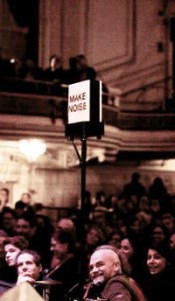 Much of my podcasting still is primarily sourced from personalities involved with either the Largo/UCB Los Angeles comedy nexus, or prominent figures from BBC4 panel shows, and are usually trivia shows or film podcasts. So there’s a degree of interactivity built in to the format, making the parasocial relationship not so surprising (he justifies somewhat defensively…). Much in the way that Jeopardy is built around the audience trying to see if they would do as well as the contestants, I listen to podcasts with an ear toward how I might have performed. Which, incidentally, almost happened: I was an alternate contestant for the touring Boston episode of Ask Me Another…, I got to dodge the bullet of actually losing live on air, and got preferred seating to safely maintain the listener relationship. The producer told me that, as an alternate, the next time I attended a performance I would be able to jump to the front of the queue and be selected. I laughed and said that I wasn’t likely I’d be in Brooklyn on a random Tuesday or Wednesday night, but that I’d keep that in mind. Seven years later, the producer has moved on from the show and I wonder both: if that offer has expired, and also if that’s why I still live in this zone of thinking that I need to keep on my toes in terms of possible participation.
Much of my podcasting still is primarily sourced from personalities involved with either the Largo/UCB Los Angeles comedy nexus, or prominent figures from BBC4 panel shows, and are usually trivia shows or film podcasts. So there’s a degree of interactivity built in to the format, making the parasocial relationship not so surprising (he justifies somewhat defensively…). Much in the way that Jeopardy is built around the audience trying to see if they would do as well as the contestants, I listen to podcasts with an ear toward how I might have performed. Which, incidentally, almost happened: I was an alternate contestant for the touring Boston episode of Ask Me Another…, I got to dodge the bullet of actually losing live on air, and got preferred seating to safely maintain the listener relationship. The producer told me that, as an alternate, the next time I attended a performance I would be able to jump to the front of the queue and be selected. I laughed and said that I wasn’t likely I’d be in Brooklyn on a random Tuesday or Wednesday night, but that I’d keep that in mind. Seven years later, the producer has moved on from the show and I wonder both: if that offer has expired, and also if that’s why I still live in this zone of thinking that I need to keep on my toes in terms of possible participation.
So I wander around my apartment answering lots of questions being asked of other people. I’m trying to choose what my favorite starter, side, main course, drink, and dessert would be in the Dream Restaurant, I’m trying to figure out what film I first remember seeing, which film I loved as a kid and think is shit now, and which film that people hate but I love and conversely which film people love but I can’t stand, and I’m determining how I would have rated a movie on a scale of 0 to 99 when I first saw it in 1999, and how those ratings would have changed today? But those are all year-’round reflections and inquiries. The timely, seasonal question over on Doug Loves Movies has been: what is the holiday movie that contestants have chosen as their favorite? Read the rest of this entry »
LE CARRÉ DIEM: Pro Patria Mori
A couple weeks ago, it was announced that David Cornwell, who had written under the pseudonym John le Carré for decades, had died. I may have found out, most banally, on Facebook, where I have subscribed to his fan page. I had enjoyed the announcements that spun out of there, most recently about the paperback edition of Agent Running In The Field — a book which I had purchased eagerly in hardback the week of its release, spurred on, no doubt by earlier announcements issuing from that same source.
It stung to hear of his passing, for entirely selfish reasons. There is literally no one on the planet who will live forever, but certain people take on the character of eternity regardless, particularly if they pre-date one and continue to flourish during one’s significant life changes. I mentioned in my Le Carré film adaptation recap series that I came to him on two fronts. The first was during a Michelle Pfeiffer-soaked adolescence ignited by her whisky-husk voice in the vinyl Catwoman outfit, but confirmed by her appearance in The Russia House, where her glamour was downplayed by the costumers and elevated by the text.
But the other source was the BBC television adaptation of Tinker, Tailor, which I did not truly deconstruct on the (still partially unfinished) series. Upon rewatching the film for the blog entry, I found myself incapable of disentangling my feelings about the film from comparisons to the miniseries. Much in the way that I don’t feel myself wholly capable of judging the Knightley/Macfadyen Pride & Prejudice, because I’m not watching it as a movie so much as I’m watching it as a condensed version of the Ehle/Firth miniseries, I can’t get Alec Guinness out of my head while watching Gary Oldman. And more than just the performance, I’m judging Alfredson on his choices in interpreting the script versus the more luxurious prior effort. It’s not really fair.
It’s additionally unfair because my attachment to Guinness’ George Smiley is significantly sentimental. Read the rest of this entry »
Birthday Present
As I left my apartment this morning, I put my weekly lunch materials — diet iced tea, cold cuts, cheddar cheese, jalapeño wraps, peanut-butter crackers, and raspberry fruit bars — into a reusable shopping bag I got a few years ago. I got it at the Institute for Contemporary Art in Boston during an event with Emily Haines. That had been my second time seeing Haines perform, and my second time ponying up for a VIP experience.
 There had been a podcast I’d listened to at some point in 2015 that had detailed an investigator’s attendance at a VIP event with Britney Spears in order to be able to ask her a question. The strangeness of the description of the event — of paying money to be part of an assembly line in order to claim that one had a “personal” experience with a celebrity — was compellingly absurd. So when an offer from Ticketmaster came to upgrade my ordinary Metric tickets to a VIP experience, I felt like I owed it to the spirit of random adventure to do so, even though I had no idea what that entailed. Because while I’d been listening to the band since discovering “Poster of a Girl” via an mp3 blog aggregator (ah, a younger internet…), they hadn’t been a band I could claim I “knew” with any real strength. In fact, an illness had kept me from attending a previous concert I’d hoped would help establish that expertise. However, found myself enamored of the essential stupidity of going to an intimate meet-and-greet session with a band I basically didn’t know.
There had been a podcast I’d listened to at some point in 2015 that had detailed an investigator’s attendance at a VIP event with Britney Spears in order to be able to ask her a question. The strangeness of the description of the event — of paying money to be part of an assembly line in order to claim that one had a “personal” experience with a celebrity — was compellingly absurd. So when an offer from Ticketmaster came to upgrade my ordinary Metric tickets to a VIP experience, I felt like I owed it to the spirit of random adventure to do so, even though I had no idea what that entailed. Because while I’d been listening to the band since discovering “Poster of a Girl” via an mp3 blog aggregator (ah, a younger internet…), they hadn’t been a band I could claim I “knew” with any real strength. In fact, an illness had kept me from attending a previous concert I’d hoped would help establish that expertise. However, found myself enamored of the essential stupidity of going to an intimate meet-and-greet session with a band I basically didn’t know.
And, well, it was brilliant. The band were welcoming and heartfelt, and we unexpectedly got to go up on stage and sing along with a song, and I felt alive and thrilled, and the whole show ranks somewhere in the top five concerts I’ve ever attended. And I decided that, as a result of how thrilling the whole experience had been, that I was going to unironically take advantage of any and every VIP opportunity that Metric provided thereafter, to chase that dragon and try to recapture that thrill.
Haines’ appearance at the Boston ICA was the next available opportunity, and since VIP access always comes with attendant merch, I left that show with the memory of breathlessly close seats and the aforementioned canvas bag that warned me that, “All the things I own, they own me.” I’ve had this bag in high rotation since I moved into a new apartment at the beginning of the summer, as I’d recently shouldered the weight of shifting my possessions across town, and of finding volunteers during Covid to huff and puff in proximity to each other while humping those possessions up and down stairs. Packing, moving, and unpacking had put a serious physical strain on me, and while I had returned to a degree of equilibrium, anxiety over maintaining work to maintain rent to not have to endure that physical gauntlet again any time soon remained. As I grew accustomed to my new digs, I wanted to remind myself not to get too comfortable, too entrenched, as my possessions were a future labor that would have their reckoning.
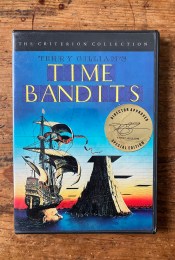
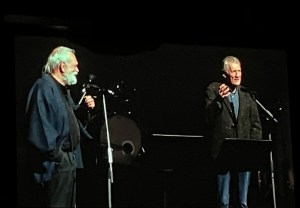
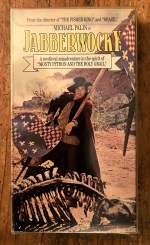

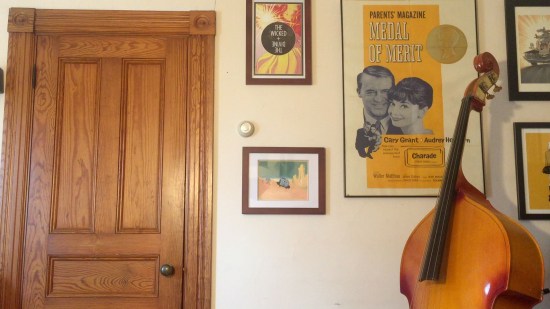

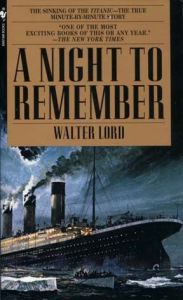
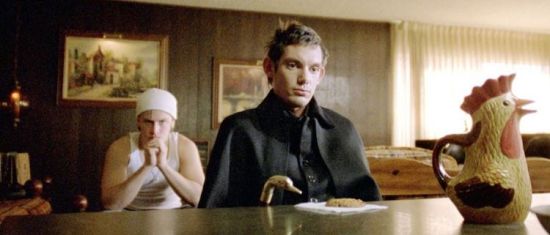


 RSS feed
RSS feed